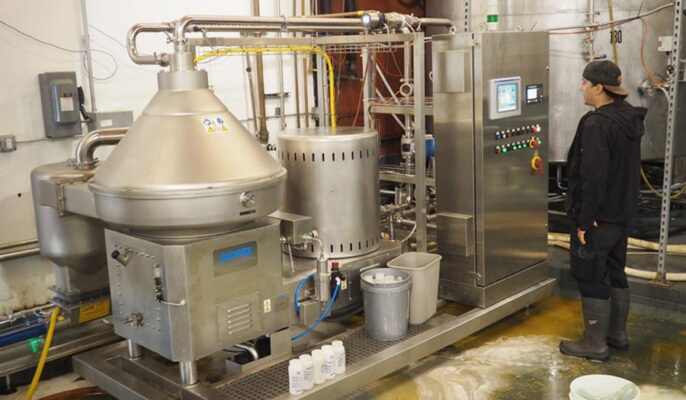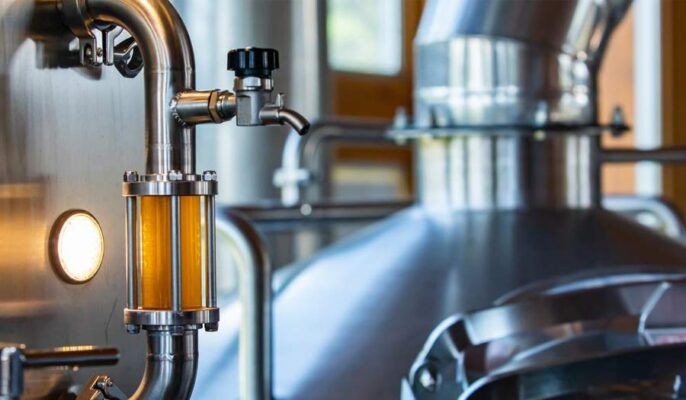Centrifuges or high-speed separators have always been the prerogative of large industrial breweries, while most small breweries need to rely on natural settling time and a variety of affordable filters. Sedimentation, clarification and filtration are important steps to separate out unwanted solids (such as residual yeast, hops and proteins) after the fermentation process and get clean beer. A challenge that every brewery faces from time to time is producing a beer that is crystal clear and free of cloudy solids. Since part of the appeal of any consumer-driven beer is its appearance and appeal, clarifying the beer becomes a top priority.
What is a beer centrifuge?
Centrifuges use centrifugal force to separate solids from liquids. For beer centrifuges in particular, any proteins, hops, yeast or other particles are removed from the beer, cleaning the liquid before transferring to the next tank – most done when transferring beer from fermentation to beer tanks.
Centrifuges for brewing use centrifugal force to create physical separation through slight acceleration in the drum and internal disk pack. Rotating at thousands of rpm also increases the settling area, clarifying and removing unwanted yeast, hops and protein solids from the beer in a short time.

Why centrifuge beer?
Traditional solids removal methods rely on ingredients settling to the bottom of a conical fermenter, which can take a considerable amount of time. The rack arms above the settled yeast are then used to separate them from the beer, and at the bottom of the cone section the hops are transferred to a maturation vessel for final conditioning.
When the cone section of the fermenter is finally cleared of these deposited solids, a considerable amount of valuable beer is lost along with these solids. Waste levels are higher for craft breweries, who use large amounts of hops depending on the beer style.
After beer has been matured at low temperatures for a period of time, there is usually some residual yeast, hops, proteins and other compounds present that can create a haze in the beer, through diatomaceous earth, candles, membrane or cartridge filters Removed, these filters can have limited solids capacity, are slow to filter, and expensive to maintain and clean.
The right centrifuge prevents oxygen absorption, producing high-quality, consistent beer with a longer shelf life.
Advantages of using a beer centrifuge
Increase production
Besides to being affordable, beer filters have several advantages for craft brewers. But they are slow and cause considerable product losses because they cannot filter the contents of the fermenter bottom without clogging. With a centrifuge, you get more beer from each tank.
Separators are the best tool ever for increasing production, with the same number of tanks you can increase production capacity by 15-20%. If you’re a small brewery, every little savings helps and your beer is liquid gold to you.
Tank turns shorter
A centrifuge can achieve the desired product consistency in a few hours, whereas settling and filtration alone would take days to do the same task.
fermented beer enters a centrifuge where it encounters many rotating plates. Solids (such as yeast, hop solids, and brewing proteins) spin to the edges and are expelled. Clarified beer remains in the center and comes off the top, all which happens without being exposed to oxygen.
Longer shelf life
Oxygen uptake is one of the biggest concerns for all breweries, especially craft breweries producing hoppy oxygen-sensitive IPAs, where it can impact the shelf life stability of the product. But that’s not something brewers need to worry about when running beer through a sealed centrifuge.

Better aroma and taste
The key to brewing great beer is having great ingredients. Unfortunately, many filtration and clarification alternatives remove the volatile aromas and flavors that need to be captured in the beer. A skimmer is the smartest way to remove desired solids from your beer while retaining the value of your unique ingredients. A separator or centrifuge retains the volatile aroma and flavor characteristics of beer better than other filtration technologies. It can only remove larger particles, while the type of downstream filtration technology can also remove finer materials.
Even if you brew a hazy beer or stout, a skimmer ensures you remove core solids and keep volatile oils and aromatics. For an already dark stout, your beer quality will be improved and shelf life stability will be improved.
An investment that pays off
Increased throughput and faster tank turnaround allow you to recoup your investment in as little as a year, depending on the setup and size of your brewery. Making a centrifuge a wise investment.
What is the difference between beer filtration and centrifugation?
Centrifugal separation is performed together with mechanical separation. G forces remove particles by weight. Lighter particles are more difficult to separate. Filtration means separating particles by size. These two technologies complement each other very well.
In brewery applications, run the separator and then the filter, especially when the goal is to extend the shelf life of the product. If you want your product to be shipped overseas or must a long shelf life in supermarkets, you may need to filter your beer, otherwise cold mist may become an issue.
If you want to produce unfiltered beer and your inventory turns over , a separate centrifuge is a very good option as the beer retains aromas and volatiles.




